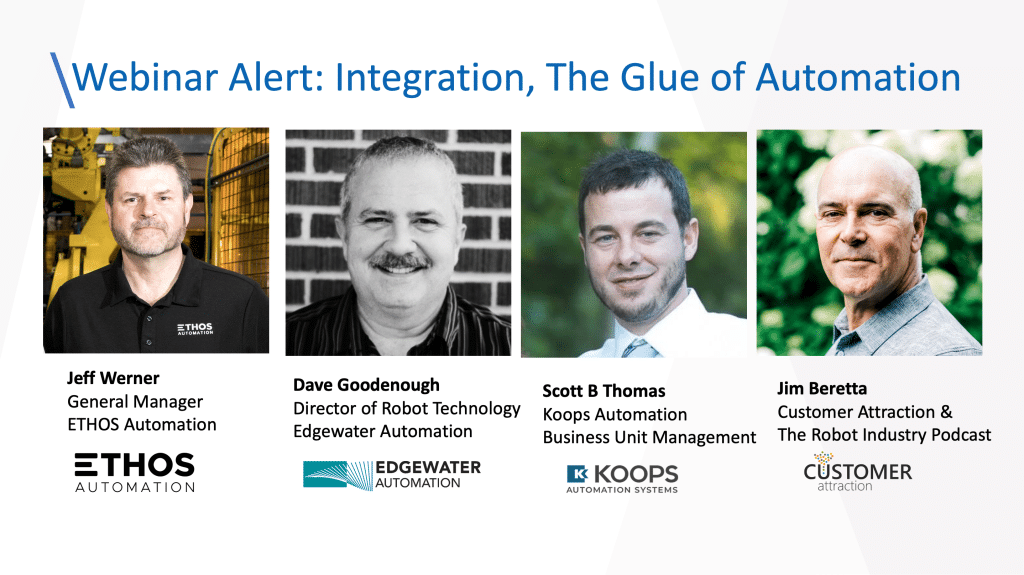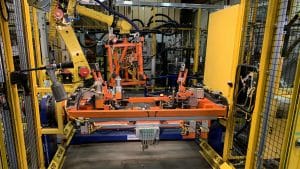Integration: The Glue of Automation
In a recent webinar hosted by the Association for Advancing Automation moderated by Jim Beretta of Customer Attraction experts Jeff Werner of Ethos Automation, Dave Goodenough of Edgewater Automation, and Scott Thomas of Koops Automation Systems to discuss the advantages and benefits of using an automation integrator.
Plug and Play robotic applications are here to stay, but the complexity that goes into making it end-user simple is more intricate than ever, and requires a great deal of coordination. That’s where a robot integrator plays a pivotal role.
A robot integrator offers expertise in:
• Applications engineering & quoting, coordinating with multiple suppliers simultaneously
• Mechanical & electrical design
• Supply chain management, including ensuring alternate sources are available
• System design and build, including retrofit and customization
• System debug
• Delivery, commissioning and coordinating training
• Warranty
• Spare parts, emergency service
Integrators are skilled at working on multiple projects simultaneously, and are able to handle different stages of automation build to keep projects moving, and are skilled at project management and managing customer and vendor relationships.
Thomas and Werner indicated some of the current trends in the industry include Autonomous Mobile Robots (AMR) and a greater demand for data. Werner added because of the increased connectivity of devices, more data is being generated, disseminated and processed, and is now a bigger component of an automation system that needs to be integrated into a customer’s manufacturing execution system (MES). Another trend Ethos is seeing is linear motion and PC-based control systems, and a resurgence in the use of redeployed robots due to supply chain challenges. Goodenough added that while robot programming is becoming easier, it is also a “double-edged sword”. Cobots are easy to program, but there aren’t many applications, and the demand for AMRs is increasing to be able to move the robots into different locations easily.
Machine learning, vision systems, artificial intelligence (AI) and augmented (AR) or virtual reality (VR) both gathers and uses data, and then transferred to a storage area that can challenge the latency of the network. Werner pointed out that one of the advantages of AR/VR can be used to troubleshoot problems from anywhere. “The operator can slip on a pair of VR goggles, and the technician can immediately see the robot. Customers often cannot wait hours or days for a service technician to arrive, and VR provides a way to expedite that. It’s going to be a continuing trend.” There aren’t always enough staff to just “jump on a plane”, and VR provides a solution. Integrators need to keep up with the technology, and it can be hard to juggle, evaluate and learn all the developments.
One of the big changes in the industry, according to Werner, is what customers are seeking when they want a automated robot solution. “Ten years ago, customers were looking for a process to be automated, whereas now, they are looking for a tool that they can redeploy themselves in different processes. Integrators are now building a flexible tool rather than a process, incorporating applications such as machine learning and AI.” Customers are now becoming more actively involved in designing the end-product, added Goodenough, which adds some unique challenges to the design and build. They want more flexibility to use it in varied ways. Clients are also looking for ways to automate to solve their labour problems.
In some ways integration has become more straightforward, as many components are readily available and no longer need to be designed from scratch. Integrators specialize in finding the right products for the customer. The challenge, however, is making the varied components work in a cohesive way and there is more pressure on the controls engineers to make the components work together. Controls design may be easier, but the programming becomes more challenging. The ability to do offline programming in simulation can minimize risk and make integration easier, but also adds to the responsibility on the controls engineer’s shoulders.
There has always been a push to provide automation solutions quickly, and the post-pandemic world has increased demand. Customers want solutions faster and more economically, and that can cause labor issues on the integrator side. Werner advises that while one solution is to run more than one shift, there can be issues associated with projects being handed between more than one software or controls engineer can create safety risks.
As customers demand more robust solutions, integrators become automation innovators. “The Magic Schoolbus” was Koops’ solution to a customer request for an AMR with a robot that could be moved from location to location to do different tasks with the same unit. Ethos’ designed a sanding solution for cabinet doors that could scan the surface, model the doors and then understand and execute the sanding profile without removing all the finish so it could be repainted. Goodenough added that integrators are often problem solvers for customers who are new to automation robotics installations and just want a final product to do what they need it to do.
AMRs are expected to continue to grow in popularity, as well as more and more devices being equipped with machine learning, AI and other evolving technology. Integrators could become more like the glue of automation, with more collaboration from outside sources rather than hiring all expertise in-house. While there are more standardized templates being used, the programming complexity continues to increase, to ensure the programming can interact correctly. Really good robotic programmers will always be in demand.
While there may be more “off the shelf” solutions available for automated robotic solutions, they still need to be “stitched together” in a cohesive unit. While robotic solutions may “seem” simpler from an end-user perspective, integrators will continue to be the glue that holds automation solutions together.
If you would like to get in touch with Jeff at Ethos Automation, here is the contact information:
Jeff Werner, General Manager | Jeff.Werner@ethosautomation.com.
Ethos Automation Inc.
70 Easton Road
Brantford, ON
N3P 1J5
(888) 384 6756 or info@ethosautomation.com

Ethos Ranks #60 on Top Companies in Canada
PRESS RELEASE | ETHOS Automation Globe and Mail Top Growth


